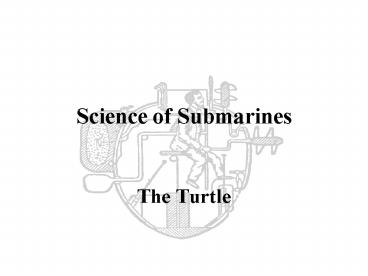Science of Submarines - PowerPoint PPT Presentation
1 / 19
Title:
Science of Submarines
Description:
... its design issues and some of its exploits during the Revolutionary War. ... weapons-delivery system. Turtle: Engineering/Design Issues ... – PowerPoint PPT presentation
Number of Views:297
Avg rating:3.0/5.0
Title: Science of Submarines
1
Science of Submarines
- The Turtle
2
The Turtle Submarine
3
Module Objectives
- Learn about the Turtle submarine, its design
issues and some of its exploits during the
Revolutionary War. - Learn about buoyancy, what makes some objects
float and others sink Archimedes Principle and
Pascals Principle. - Learn about stability, what keeps objects upright
on and below the ocean surface.
4
The Turtle
- Propelled by pedals and cranks, hand-and-foot
operated - Descended using valve to admit water to ballast
tank, ascended using pumps to eject water - Equipped with a depth gauge, a compass, and a
ventilator to supply fresh air when the vessel
was on the surface.
5
The Turtle
- Inflicted no damage to any British vessel, but
changed course of British strategy through her
use as a potential weapon - Alleged to have been sunk by British while being
transported to a battle site - From a warrior's mentality, the submarine was
a great addition to the world's war arsenal
6
Turtle Engineering/Design Issues
- Engineering/design problems that had to be solved
with the technology of the time - watertight, pressure-proof hull
- vertical and horizontal propulsion
- vertical stability
- variable ballast
- steering controls
- weapons-delivery system.
7
Turtle Engineering/Design Issues
- Engineering/design problems that had to be solved
with the technology of the time - watertight, pressure-proof hull
- vertical and horizontal propulsion
- vertical stability
- variable ballast
- steering controls
- weapons-delivery system.
8
Turtle Engineering/Design Issues
- Engineering/design problems that had to be solved
with the technology of the time - watertight, pressure-proof hull
- vertical and horizontal propulsion
- vertical stability
- variable ballast
- steering controls
- weapons-delivery system.
9
(No Transcript)
10
Turtle Engineering/Design Issues
- Engineering/design problems that had to be solved
with the technology of the time - watertight, pressure-proof hull
- vertical and horizontal propulsion
- vertical stability
- variable ballast
- steering controls
- weapons-delivery system.
11
Turtle Engineering/Design Issues
- Engineering/design problems that had to be solved
with the technology of the time - watertight, pressure-proof hull
- vertical and horizontal propulsion
- vertical stability
- variable ballast
- steering controls
- weapons-delivery system.
12
Buoyancy To Float or Not to Float
- Archimedes PrincipleAny object comp-letely or
partially immersed in a fluid (liquid or gas) is
buoyed up by a force equal to the weight of the
displaced fluid. - Pascals Principle Any change in pressure in
a fluid is transmitted undiminished through the
fluid
13
Some Terminology Metric Units
- Mass is the amount of matter in an object units
kilograms - Weight is the measure of the force of attraction
between objects due to gravity. units newtons - Volume is the amount of space an object takes up
units liters, meters3 - Density is mass per unit volume units
grams/cubic centimeter (g/cc)
14
Virtual Density Lab
- Use the tools in the Virtual Lab to find the mass
and volume of the various objects. - Drop the objects in the pail of water to see if
they sink or float. - Find a relationship between the mass and volume
of the objects predict whether the objects float
or sink. - Density Lab
15
Some Density Results
16
Stability
- Consider a submarine with mass m, and displaced
volume V below the waterline. - The center of buoyancy (CB) is the mathematical
average of all points below the waterline less
dense than water. - The center of mass (CM) is the mathematical
average of all masses mechanically linked to the
submarine. - If CM is lower than the CB, the ship is said to
be stable. If CM is above CB, the ship is
unstable. - Stability graphic
17
References
18
Computational Project Ideas
- The density of sea water is a function of
pressure, temperature, and salinity. The flux of
heat in and out of the ocean is constrained
largely to the layer near the surface. At depth
the ocean is approxi-mately adiabatic (no sources
or sinks of heat). Find a formula which
approximates density in sea water and calculate
sea water densities for various oceans around the
world. Compare your results with published data.
19
Computational Project Ideas
- In the early 1940s, the US submarine Squalus
was raised from the ocean floor by attaching
air-filled pontoons to it. Consider the problem
of raising an object of constant density from the
ocean floor by attaching pontoons to it to
increase its buoyancy. Bring the object to the
ocean surface in an upright position.































